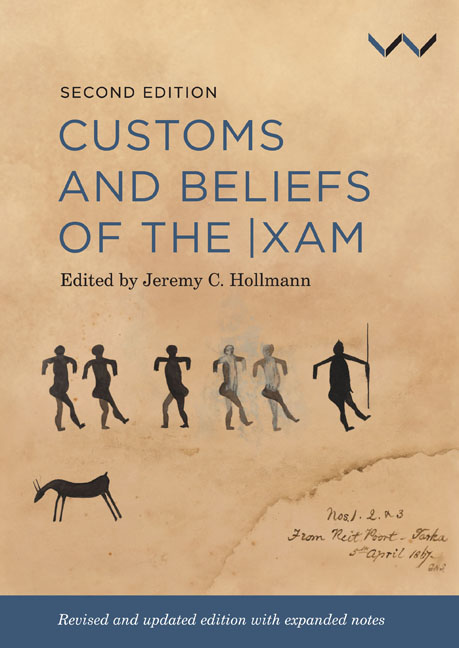Book contents
- Frontmatter
- Dedication
- Contents
- Acknowledgements
- Foreword To The Second Edition
- Foreword To The First Edition
- Introduction
- Contributors
- The |Xam Language
- The People In The Notebooks
- Part 1 Baboons
- Part 2 The Lion
- Part 3 Game Animals
- Part 4 Omens, Windmaking, Clouds
- Part 5 Rain
- Part 6 Rainmaking
- Part 7 Sorcerers
- Part 8 More About Sorcerers and Charms
- Part 9 Special Speech of Animals and Moon
- Appendix 1 |Xam Grammar
- Appendix 2 Summary of The Narratives
- References
- Index
Part 4 - Omens, Windmaking, Clouds
Published online by Cambridge University Press: 24 November 2023
- Frontmatter
- Dedication
- Contents
- Acknowledgements
- Foreword To The Second Edition
- Foreword To The First Edition
- Introduction
- Contributors
- The |Xam Language
- The People In The Notebooks
- Part 1 Baboons
- Part 2 The Lion
- Part 3 Game Animals
- Part 4 Omens, Windmaking, Clouds
- Part 5 Rain
- Part 6 Rainmaking
- Part 7 Sorcerers
- Part 8 More About Sorcerers and Charms
- Part 9 Special Speech of Animals and Moon
- Appendix 1 |Xam Grammar
- Appendix 2 Summary of The Narratives
- References
- Index
Summary
In Part 4, the three narrators – ‖kɑbbo (one narrative), Diäǃkwɑin and |hɑŋǂkɑssʼo (five narratives each) – reveal the connections between people, and between people and the weather, wind and animals, specifically springbok.
There are many different types of omens or presentiments in the |xɑm world (for a summary and discussion of presentiments, see Canetti [2002]). One is called ǃgweː (’ letter, picture’, Bleek 1956: 392), of which an example is ‘the springbok sensation’ that ‖kɑbbo describes (A2.1.034, L.II.28: 2531–2565; Bleek & Lloyd 1911: 330–339; De Prada-Samper 2014b). A second is |khɑmmɑ (‘sneezing’), an apparently telepathic response to the conversation of other people who are emotionally close but physically far away. Like houŋ, the presentiments that Diäǃkwɑin talks about in Narrative 7.16, and the dreams and conversations that ‖kɑbbo has with his absent wife and family (‘Jantje Tooren tells me his Dream’, A2.1.028, L.II.22: 1949–1964; Lewis-Williams 2000: 131–132), sneezing connects people who are eager for news and contact with their families. Sneezing also affects the relationship between the hunter and his wounded prey, as well as other animals (see Parts 1 and 3 for sneezing in other contexts). The hunter's behaviour and that of the wounded animal are intertwined: disrespectful and inappropriate behaviour such as sneezing, which startles the game, could sever that connection and thus set the animal free.
But the most sensitive and pervasive relationships in the Customs and Beliefs narratives are those between people, the weather (especially the wind) and the behaviour of springbok.
Relationships with the wind
A little over half of the Part 4 narratives concern interaction between people and wind. Diäǃkwɑin's account of his father's death (Narrative 4.4) brings to the fore beliefs about the relationship between people, their environment, and the unseen links between them. Since some of these elements feature in all of the narratives, they require some explanation here.
Dreaming, like sneezing and presentiments, is a way of knowing things about people far away. In the dream (Narrative 4.4), Diäǃkwɑin's father blinks at him (dɑbbɑ-dɑbbɑ); then his father dies and the rain wind (ǃkhwɑː-kɑ ǃkhwe) from the north comes up, bringing rain. Diäǃkwɑin goes to look for his father and learns from his mother that his father has indeed died, and that a wind from the north had come up, driving a multitude of springbok in front of it.
- Type
- Chapter
- Information
- Customs and Beliefs of the |xam , pp. 149 - 186Publisher: Wits University PressPrint publication year: 2022



